Toyota RAV4: Using other driving systems
Cruise control
Use the cruise control to maintain a set speed without depressing the accelerator pedal.
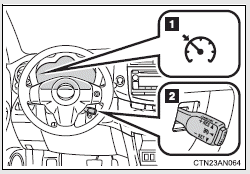
1 Indicator
2 Cruise control switch
Setting the vehicle speed
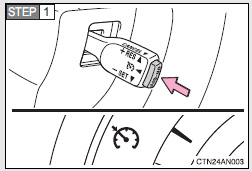
Press the “ON-OFF” button to activate the cruise control. Cruise control indicator will come on. Press the button again to deactivate the cruise control.
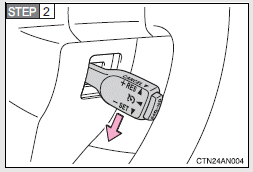
Accelerate or decelerate the vehicle to the desired speed, and push the lever down to set the speed. The vehicle speed at the moment the lever is released becomes the set speed.
Adjusting the set speed
To change the set speed, operate the lever until the desired set speed is obtained.
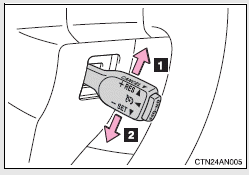
1 Increase the speed
2 Decrease the speed
Hold the lever until the desired speed setting is obtained. Fine adjustment: Momentarily move the lever in the desired direction. Large adjustment: Hold the lever in the desired direction. The set speed will be increased or decreased as follows:
Fine adjustment: By approximately 1 mph (1.6 km/h) each time the lever is operated. Large adjustment: The set speed can be increased or decreased continually until the lever is released.
Canceling and resuming the constant speed control
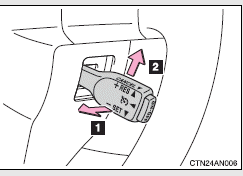
1 Pulling the lever toward you cancels the constant speed control.
The speed setting is also canceled when the brakes are applied.
2 Pushing the lever up resumes the constant speed control. Resuming is available when the vehicle speed is more than approximately 25 mph (40 km/h).
Cruise control can be set when
●The shift lever is in D or 3 (4-speed models), or D or 4 (5-speed models).
●Vehicle speed is above approximately 25 mph (40 km/h).
■Accelerating after setting the vehicle speed
●The vehicle can be accelerated normally. After acceleration, the set
speed resumes.
●Even without canceling the cruise control, the set speed can be
increased by first accelerating the vehicle to the desired speed and then
pushing the lever down to set the new speed.
Coast braking function
●Holding the lever down to decrease the set speed activates the brake
system automatically, decelerating the vehicle quickly.
While the brake system is operating, the stop lights and high mounted
stoplight will turn on.
●A sound may be heard from the engine compartment during the operation
of the brake system. The sound means the brake system is operating
and it does not indicate a malfunction.
Automatic cruise control cancelation
Cruise control will stop maintaining the vehicle speed in any of the following situations.
●Actual vehicle speed falls more than approximately 10 mph (16 km/h)
below the preset vehicle speed.
At this time, the memorized set speed is not retained.
●Actual vehicle speed is below approximately 25 mph (40 km/h).
●VSC is activated.
If the cruise control indicator light flashes
Press the “ON-OFF” button once to deactivate the system, and then press the button again to reactivate the system. If the cruise control speed cannot be set or if the cruise control cancels immediately after being activated, there may be a malfunction in the cruise control system. Have the vehicle inspected by your Toyota dealer.
CAUTION
■To avoid operating the cruise control by mistake
Switch the cruise control off using the “ON-OFF” button when not in use.
■Situations unsuitable for cruise control
Do not use cruise control in any of the following situations.
Doing so may result in loss of control and could cause an accident resulting
in death or serious injury.
●In heavy traffic
●On roads with sharp bends
●On winding roads
●On slippery roads, such as those covered with rain, ice or snow
●On steep hills
Vehicle speed may exceed the set speed when driving down a steep hill.
●When your vehicle is towing a trailer or during emergency towing
Rear view monitor system (vehicles with auto anti-glare inside rear view mirror)
The rear view monitor system assists the driver by displaying an image of the area behind the vehicle. The image is displayed in reverse on the screen. This reversed image is a similar image to the one on the inside rear view mirror.
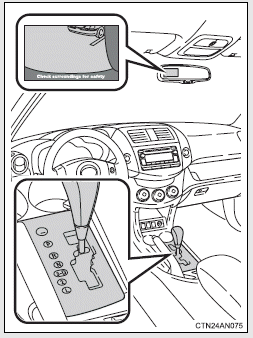
The rear view image is displayed on the inside rear view mirror. The screen turns off in the following situations:
• The shift lever is shifted out
of R.
• The back door is opened.
• The screen remains on for
approximately 5 minutes.
The rear view monitor system can be operated when
Vehicles without smart key system
The shift lever is in R, the back door is fully closed and the engine switch is in the “ON” position.
Vehicles with smart key system
The shift lever is in R, the back door is fully closed and the “ENGINE START STOP” switch is in IGNITION ON mode.
Changing display modes
The rear view monitor display mode can be changed while the screen is on.
●To temporarily disable the rear view monitor system
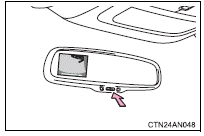
Push the “AUTO” button. The indicator will turn amber.
Vehicles without smart key system
The system will be re-enabled once the engine switch is turned OFF and then turned to the “ON” position.
Vehicles with smart key system
The system will be re-enabled once the “ENGINE START STOP” switch is turned OFF and then turned to IGNITION ON mode.
●To constantly disable the rear view monitor system
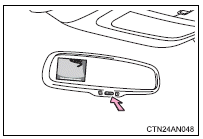
Push and hold the “AUTO” button for 12 to 15 seconds. The screen will turn off and on after 6 seconds. Keep pushing the button until the screen turns back off. The indicator will flash amber.
Vehicles without smart key system
The system will not automatically turn on again after the engine switch is OFF and then turned to the “ON” position.
Vehicles with smart key system
The system will not automatically turn on again after the “ENGINE START STOP” switch is OFF and then turned to IGNITION ON mode.
●To re-enable the rear view monitor system Push the “AUTO” button. The indicator will turn green.
Selecting a language (English, French or Spanish)
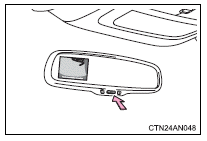
1 Push and hold the “AUTO” button for 6 to 12 seconds. The screen will turn on and the indicator will turn green.
2 Push the “AUTO” button. Each time the “AUTO” button is pushed and released, the language changes. A message will flash in the mirror for 5 seconds after the button is released, indicating that the change has been completed.
Displayed area
Vehicles without spare tire
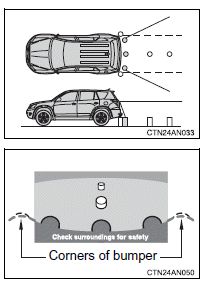
The area covered by the camera is limited. Objects that are close to either corner of the bumper or under the bumper cannot be seen on the screen. The area displayed on the screen may vary according to vehicle orientation or road conditions.
Vehicles with spare tire

The area covered by the camera is limited. Objects that are close to either corner of the bumper or under the bumper cannot be seen on the screen. The area displayed on the screen may vary according to vehicle orientation or road conditions. The area displayed on the screen is reduced because the spare tire partially blocks the field of view of the camera. Also, the rear mounted spare tire extends past the rear bumper.
Rear view monitor system camera
Vehicles without spare tire
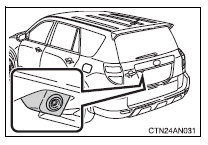
In the following cases, it may become difficult to see images on the screen even if the system functions correctly.
●The vehicle is in a dark area, such
as at night.
●The temperature near the lens is
extremely high or low.
●Water droplets are on the camera
lens or humidity is high, such as
when it rains.
●Foreign matter, such as snow or
mud, adheres to the camera lens.
●The camera lens is scratched or has
dirt on it.
●The sun or headlights are shining
directly into the camera lens.
●A bright object such as a white wall
is reflected in the mirror surface
over the screen.
Vehicles with spare tire
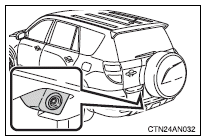
In the following cases, it may become difficult to see images on the screen even if the system functions correctly.
●The vehicle is in a dark area, such
as at night.
●The temperature near the lens is
extremely high or low.
●Water droplets are on the camera
lens or humidity is high, such as
when it rains.
●Foreign matter, such as snow or
mud, adheres to the camera lens.
●The camera lens is scratched or has
dirt on it.
●The sun or headlights are shining
directly into the camera lens.
●A bright object such as a white wall
is reflected in the mirror surface
over the screen.
Smear effect
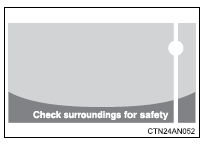
If a bright light, such as sunlight reflected off the vehicle body, is picked up by the camera, a smear effect* characteristic to the camera may occur.
*: Smear effect: A phenomenon that occurs when a bright light is picked up by the camera; when transmitted by the camera, the light source appears to have a vertical streak above and below it.
Flicker effect
When the camera is used under fluorescent light, sodium lights, or mercury lights etc., the lights and the illuminated areas may appear to flicker.
CAUTION
■When using the rear view monitor system
Observe the following precautions to avoid an accident that could result in
death or serious injuries.
●The rear view monitor system is a supplement device intended to assist
back up. Never depend solely on the rear view monitor system when
reversing. Always check visually and with the mirrors to confirm your
intended path is clear. Use caution just as you would when backing up any
vehicle.
●The camera has a special lens. Depicted distances between objects and
flat surfaces differ from actual distances.
●Vehicles with spare tire: The spare tire is the rear-most edge of the vehicle
extending past the rear bumper. Take care not to hit any obstacles with the
spare tire while reversing.
■Conditions which may affect the rear view monitor system
●If the back of the vehicle has been hit, the camera’s position and mounting
angle may have changed. Have the vehicle inspected by your Toyota
dealer.
●When the outside temperature is low, the displayed image may become
faint or dark, and moving images will be distorted, or not entirely visible.
●Rapid temperature changes, such as when hot water is poured on the
vehicle in cold weather, may cause the system to function abnormally.
●If the camera lens is dirty, it cannot transmit a clear image. Rinse with
water and wipe with a soft cloth. If the camera lens is extremely dirty, wash
with a mild cleanser and rinse.
●When replacing tires, please consult your Toyota dealer. If you replace the
tires, the area displayed on the screen may change.
NOTICE
■To prevent damage to the camera
●As the camera has a water proof construction, do not detach, disassemble
or modify it. This may cause incorrect operation.
●When washing the vehicle, do not apply intensive bursts of water to the
camera or camera area. Doing so may result in camera malfunctions.
●Take care so that organic solvent, car wax, window cleaner or glass coat
does not adhere to the camera. If this happens, wipe it off as soon as possible.
Driving assist systems
To help enhance driving safety and performance, the following systems operate automatically in response to various driving situations. Be aware, however, that these systems are supplementary and should not be relied upon too heavily when operating the vehicle.
■ ABS (Anti-lock Brake System)
Helps to prevent wheel lock when the brakes are applied suddenly, or if the brakes are applied while driving on a slippery road surface.
■ Brake assist
Generates an increased level of braking force after the brake pedal is depressed, when the system detects a panic stop situation.
■ VSC (Vehicle Stability Control)
Helps the driver to control skidding when swerving suddenly or turning on slippery road surfaces.
■ TRAC (Traction Control)
Maintains drive power and prevents the drive wheels from spinning when starting the vehicle or accelerating on slippery roads.
■ AUTO LSD function (2WD models)
The AUTO LSD function is activated when the system is in TRAC off mode. It operates when one of the drive wheels is spinning, such as when the wheel is spinning freely on ice or mud. The system applies the brakes to the spinning wheel and transfers some of the torque to the other wheel to secure drive power.
■ Active Torque Control 4WD system (4WD models)
Automatically switches from front-wheel drive to four-wheel drive (4WD) according to the driving conditions, helping to ensure reliable handling and stability. Examples of conditions where the system will switch to 4WD are when cornering, going uphill, starting off or accelerating, and when the road surface is slippery due to snow, rain, etc.
■ EPS (Electric Power Steering)
Employs an electric motor to reduce the amount of effort needed to turn the steering wheel.
■ Enhanced VSC (Enhanced Vehicle Stability Control)
Provides cooperative control of the ABS, TRC, VSC and EPS. Helps to maintain directional stability when swerving on slippery road surface by controlling steering performance.
When the VSC/TRAC are operating
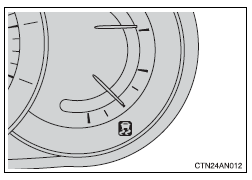
If the vehicle is in danger of slipping or if any of the drive wheels spins, the slip indicator light flashes to indicate that the VSC/ TRAC systems are operating. A buzzer (intermittent) sounds to indicate that VSC is operating.
To disable TRAC and/or VSC (2WD models)
If the vehicle gets stuck in fresh snow or mud, TRAC and VSC may reduce power from the engine to the wheels. You may need to turn the system off to enable you to rock the vehicle in order to free it. The AUTO LSD function is activated when the system is in TRAC off mode.
■ Turning off TRAC
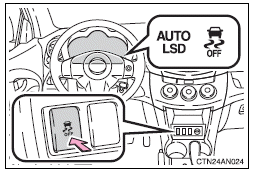
Quickly push and release the switch to turn off TRAC. The “AUTO LSD” and VSC OFF indicator lights should come on. While the AUTO LSD function is operating the slip indicator light flashes. Push the switch again to turn the system back on.
■ Turning off TRAC and VSC
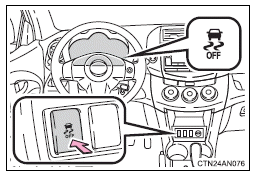
Push and hold the switch while the vehicle is stopped to turn off TRAC and VSC. The VSC OFF indicator light should come on. Push the switch again to turn the system back on.
To disable TRAC and/or VSC (4WD models)
If the vehicle gets stuck in fresh snow or mud, TRAC and VSC may reduce power from the engine to the wheels. You may need to turn the system off to enable you to rock the vehicle in order to free it.
■ Turning off TRAC
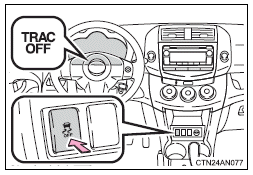
Quickly push and release the switch to turn off TRAC. The “TRAC OFF” indicator light should come on. Push the switch again to turn the system back on.
■ Turning off TRAC and VSC
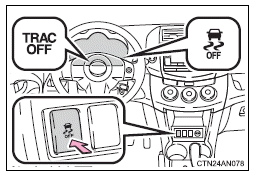
Push and hold the switch while the vehicle is stopped to turn off TRAC and VSC. The “TRAC OFF” and VSC OFF indicator lights should come on. Push the switch again to turn the system back on.
■Automatic reactivation of TRAC and VSC
Vehicles without smart key system
Turning the engine switch OFF after turning off the TRAC and VSC systems will automatically re-enable them.
Vehicles with smart key system
Turning the “ENGINE START STOP” switch OFF after turning off the TRAC and VSC systems will automatically re-enable them.
■Automatic TRAC reactivation
2WD models
If only the TRAC system is turned off, the TRAC system will be reactivated while vehicle speed is increased.
4WD models
If only the TRAC system is turned off, the TRAC system will turn on when vehicle speed increases.
■Automatic TRAC and VSC reactivation
If the TRAC and VSC systems are turned off, the systems will not turn on even when vehicle speed increases.
■When the “AUTO LSD” indicator light flashes even if the VSC OFF switch has not been pressed (2WD models)
TRAC, AUTO LSD, hill-start assist control and downhill assist control cannot be operated. Contact your Toyota dealer.
■When the “TRAC OFF” indicator light comes on even if the VSC OFF switch has not been pressed (4WD models)
TRAC, hill-start assist control and downhill assist control cannot be operated. Contact your Toyota dealer.
■Sounds and vibrations caused by the ABS, TRAC and VSC
●A sound may be heard from the engine compartment when the engine is
started or just after the vehicle begins to move. This sound does not indicate
that a malfunction has occurred in any of these systems.
●Any of the following conditions may occur when the above systems are
operating. None of these indicates that a malfunction has occurred.
• Vibrations may be felt through the vehicle body and steering.
• A motor sound may be heard after the vehicle comes to a stop.
• The brake pedal may pulsate slightly when the ABS is activated.
• The brake pedal may move down slightly after the ABS is activated.
■When the AUTO LSD function operates continuously
The brake actuator may overheat. In that case, the system will stop the AUTO LSD function, a buzzer will sound and the slip indicator will stay on steady. Refrain from using the AUTO LSD function until the slip indicator goes off. (There is no problem with continuing driving normally.)
■EPS operation sound
When the steering wheel operates, a motor sound (whirring sound) may be heard. This does not indicate a malfunction.
■Reduced effectiveness of EPS system
The effectiveness of EPS system is reduced to prevent the system from overheating when there is frequent steering input over an extended period of time. The steering wheel may feel heavy as a result. Should this occur, refrain from excessive steering input or stop the vehicle and turn the engine off. The EPS system should return to normal within 10 minutes.
■If the slip indicator comes on
It may indicate a malfunction in the VSC, TRAC and AUTO LSD function. Contact your Toyota dealer.
CAUTION
■The ABS does not operate effectively when
●Tires with inadequate gripping ability are used (such as excessively worn
tires on a snow covered road).
●The vehicle hydroplanes while driving at high speed on wet or slick road.
■Stopping distance when the ABS is operating may exceed that of normal
conditions
The ABS is not designed to shorten the vehicle's stopping distance. Always
maintain a safe distance from the vehicle in front of you in the following
situations.
●When driving on dirt, gravel or snow-covered roads
●When driving with tire chains
●When driving over bumps in the road
●When driving over roads with potholes or roads with uneven surfaces
■TRAC may not operate effectively when
Directional control and power may not be achievable while driving on slippery
road surfaces, even if the TRAC system is operating.
Do not drive the vehicle in conditions where stability and power may be lost.
■When the VSC is activated
The slip indicator flashes and a warning buzzer sounds. Always drive carefully.
Reckless driving may cause an accident. Exercise particular care when
the indicator light flashes and a buzzer sounds.
■When TRAC and VSC are off
Be especially careful and drive at a speed appropriate to the road conditions.
As these are systems to ensure vehicle stability and driving force, do
not turn off TRAC and VSC unless necessary.
■Replacing tires
Make sure that all tires are of the same size, brand, tread pattern and total
load capacity. In addition, make sure that the tires are inflated to the
appropriate
tire pressure level.
The ABS and VSC systems will not function correctly if different tires are
fitted
on the vehicle.
Contact your Toyota dealer for further information when replacing tires or
wheels.
■Handling of tires and suspension
Using tires with any kind of problem or modifying the suspension will affect
the driving assist systems, and may cause the system to malfunction.
Hill-start assist control
Hill-start assist control helps to prevent the vehicle from rolling backwards when starting on an incline or slippery slope.
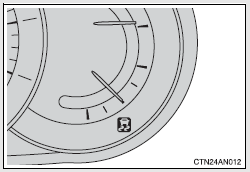
To engage hill-start assist control, further depress the brake pedal when the vehicle is stopped completely. A buzzer will sound once to indicate the system is activated. The slip indicator will also start flashing.
■Hill-start assist control operating conditions
• The shift lever is in a position other than P.
• The parking brake is not applied.
• The accelerator pedal is not depressed.
■Hill-start assist control
●While hill-start assist control is operating, the brakes remain
automatically
applied after the driver releases the brake pedal. The stop lights and
the high mounted stoplight turn on.
●Hill-start assist control operates for about 2 seconds after the brake pedal
is released.
●If the slip indicator does not flash and the buzzer does not sound when
the brake pedal is further depressed, slightly reduce the pressure on the
brake pedal (do not allow the vehicle to roll backward) and then firmly
depress it again. If the system still does not operate, check if the operating
conditions explained above have been met.
■Hill-start assist control buzzer
●When hill-start assist control is activated, the buzzer will sound once
when the shift lever is in a position other than R.
●In the following situations, hill-start assist control will be canceled and the
buzzer will sound twice when the shift lever is in a position other than R.
• No attempt is made to drive the vehicle within approximately 2 seconds
of releasing the brake pedal.
• The shift lever is moved to P.
• The parking brake is applied.
• The brake pedal is depressed again.
●When the shift lever is in R, the buzzer indicating the start and end of the operation does not sound. Use the slip indicator status (flashing or off) to confirm if hill-start assist control is operating.
■If the slip indicator comes on
It may indicate a malfunction in the system. Contact your Toyota dealer.
CAUTION
■Hill-start assist control
●Do not overly rely on hill-start assist control. Hill-start assist control may
not operate effectively on extremely steep inclines or roads covered in ice.
●Unlike the parking brake, hill-start assist control is not intended to hold the
vehicle stationary for an extended period of time. Do not attempt to use
hill-start assist control to hold the vehicle on an incline for an extended
period of time, as doing so may lead to an accident.
Downhill assist control system
With the downhill assist control system, the vehicle is able to descend a steep hill while maintaining a constant low speed of about 3 mph (5 km/h) without brake pedal operation.
■ Activating the downhill assist control system
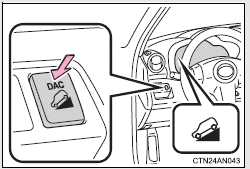
Press the “DAC” switch. The downhill assist control system indicator will come on to indicate that the downhill assist control system is activated. Pressing the switch again turns the system off.
While the downhill assist control system is operating
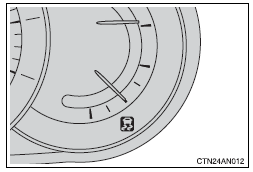
The slip indicator will flash to indicate that the downhill assist control system is operating, and the stop lights and high mounted stoplight will turn on.
■Conditions in which the downhill assist control system does not operate or will stop operating
●In the following situations, the downhill assist control system indicator flashes and the downhill assist control system does not operate or will stop operating:
• The shift lever is not in L or R.
• The vehicle speed is higher than 15 mph (25 km/h).
●If the accelerate or brake pedal is depressed, the downhill assist control system will stop operating with the downhill assist control system indicator stayed on.
■If the “DAC” switch is turned off while the downhill assist control system is operating
The downhill assist control system gradually ceases operation. The downhill assist control system indicator will flash during the canceling operation, and then go off when the system is fully off.
■Downhill assist control system operation sound
●A sound may be heard from the engine compartment while the downhill
assist control system is operating. This sound does not indicate a
malfunction.
●If the accelerator or brake pedal is depressed while the downhill assist
control system is operating, a sound caused by the release of system
operation may be heard, or you may feel the brake pedal push-back. This
does not indicate a malfunction.
■When the downhill assist control system operates continuously
The brake actuator may overheat. In that case, the downhill assist control system will stop operating, a buzzer will sound and the downhill assist control system indicator will start flashing. Refrain from using the system until the downhill assist control system indicator stays on. (There is no problem with continuing driving normally.)
■If the slip indicator comes on
It may indicate a malfunction in the system. Contact your Toyota dealer.
CAUTION
■Conditions which may affect the downhill assist control system operation
●Do not rely too heavily on the downhill assist control system. On extremely
steep inclines, icy surfaces or muddy roads, the vehicle may slip and the
system may not be able to maintain the constant low vehicle speed of
about 3 mph (5 km/h), leading to an accident causing death or serious
injury.
●Do not shift the shift lever to R while driving forward, or to D while driving
backward. Doing so may cause the wheels to lock up, leading to an accident
causing death or serious injury. In addition, excessive stress will be
applied to the automatic transmission, possibly resulting in damage.
Four-wheel drive lock switch (4WD models)
Four-wheel drive lock mode can be used when a large amount of drive power needs to be applied to all the wheels, such as when the vehicle gets stuck in mud and you need to free it.
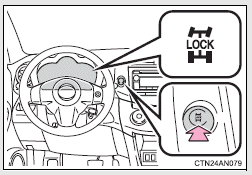
Press the switch. The torque of the engine is distributed to the rear wheels to the maximum extent possible in accordance with driving conditions. Pressing the switch again cancels four-wheel drive lock mode and returns the Active Torque Control 4WD system to normal mode.
■Four-wheel drive lock mode can be operated when
Vehicles without smart key system
The engine switch is in the “ON” position
Vehicles with smart key system
The “ENGINE START STOP” switch is in IGNITION ON mode.
Four-wheel drive lock mode
●Four-wheel drive lock mode is canceled when the brakes are applied to
ensure the ABS and VSC systems operate effectively.
●Four-wheel drive lock mode is canceled when the vehicle speed exceeds
25 mph (40 km/h).
See also:
Driving in foreign countries
When planning to use your vehicle in
another country:
- Confirm the availability of the correct
fuel. Refer to “Fuel requirements”.
- Comply with all regulations and requirements
of each country. ...
Checking and changing the engine coolant
WARNING:
Do not remove the radiator cap when the
engine is hot. When the engine is hot, the
engine coolant is under pressure and may
erupt through the opening if the cap is
removed. You could be seriously burned if
you do not observe this ...

 Operating the lights and wipers
Operating the lights and wipers